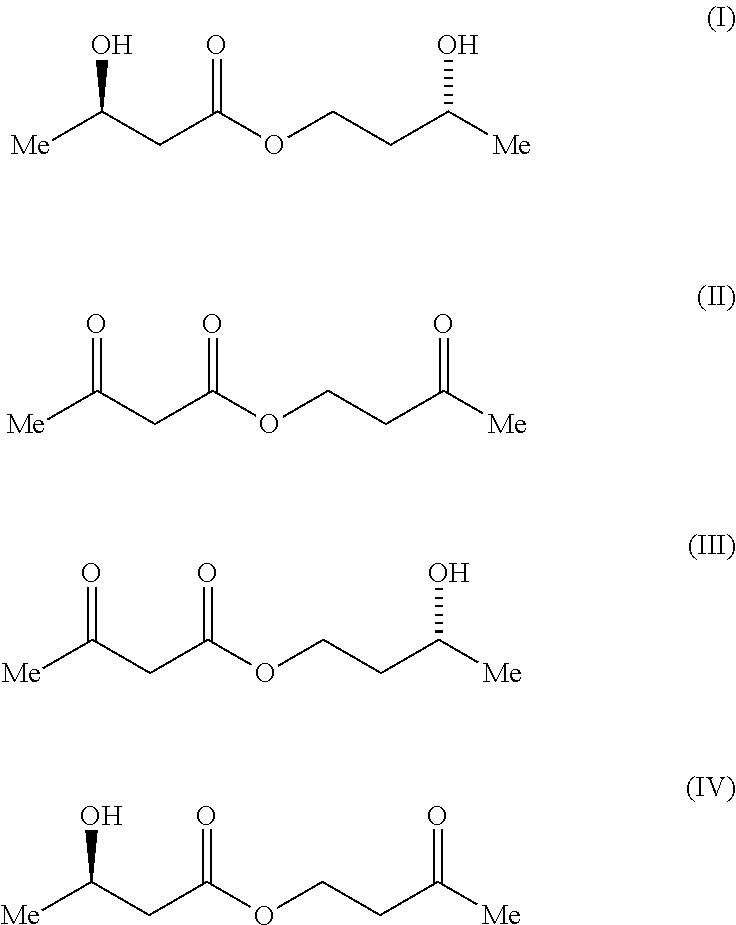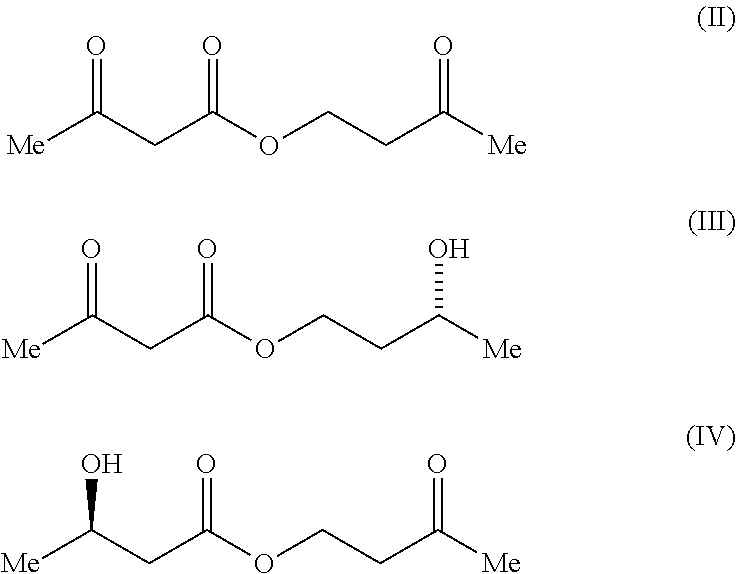Process for the preparation of (3R)-hydroxybutyl (3R)-hydroxybutyrate by enzymatic enantioselective reduction employing Lactobacillus brevis alcohol dehydrogenase
a technology of enantioselective reduction and hydroxybutyl, which is applied in the field of synthesis of 3hydroxybutyl 3hydroxybutyrate in enantiomerically enriched form, can solve the problems of low yield, production of impure products, and inability to achieve large-scale application
- Summary
- Abstract
- Description
- Claims
- Application Information
AI Technical Summary
Benefits of technology
Problems solved by technology
Method used
Image
Examples
example 1
Enzymatic Reduction of 3-oxobutyl acetoacetate
1. Enzyme Activity Screening
[0185]A range of alcohol dehydrogenases was screened for activity toward 3-oxobutyl acetoacetate, formula (II), by monitoring cofactor consumption at 340 nm over time (Table 1). The enzymes screened were ADH from Lactobacillus brevis (ADH-LB), ADH 1 and 2 from Rhodococcus sp. (ADH-RS1 and ADH-RS2), ADH from. Thermoanaerobacter sp. (ADH-T) and ADH 1 and 2 from Lactobacillus kefir (CDX 003 and CDX 013 respectively).
[0186]
TABLE 1Spectrophotometric screening of various ADHs for activitytoward 3-oxobutyl acetoacetateRelativeAlcohol dehydrogenaseActivityactivity1ADH-LB825U / mL114%ADH-RS1471U / mL170%ADH-RS290U / mL170%ADH-T157U / mL10%CDX 0039U / mg28%CDX 013U / mg—1Activity relative to standard substrate
The highest activities were obtained with ADH LB and ADH RS1. These two enzymes were selected from studying the bioreductions on analytical scale.
2. Bioreduction of 3-oxobutyl acetoacetate by ADH LB and ADH RS1
[0187]The formul...
example 2
Production of 3-oxobutyl acetoacetate (II) from Diketene and 4-hydroxybutan-2-one
[0205]A solution of 4-hydroxybutan-2-one (8.6 mL, 100 mmol) and triethylamine (55 μL, 0.004 equiv.) in chloroform (25 mL) was heated to 60° C. Diketene (8.1 mL, 1.05 equiv.) was added dropwise [CARE: there is a short induction period] and the reaction was stirred at this temperature for a further 45 min by which time NMR analysis indicated the reaction to be complete. The solvent was removed in vacuo and the residue was distilled (Kugelrohr, ca. 0.5 mm Hg, oven temperature 120° C. to remove a short fore-run then the product distilled when the oven temperature was raised to 160° C.) to give the pure product (II) as a colourless oil (13.2 g, 77%). δH (200 MHz, CDCl3) 2.19 (3 H, s) and 2.25 (3 H, s, 2×CH3), 2.80 (2 H, t, J 6.2 Hz, CH2CO), 3.44 (2 H, s, CH2(CO)2), 4.40 (2 H, t, J 6.2 Hz, CH2O) [resonances due to the minor enol tautomer were observed at 1.92 and 4.95 p.p.m.].
PUM
| Property | Measurement | Unit |
|---|---|---|
| pH | aaaaa | aaaaa |
| temperature | aaaaa | aaaaa |
| temperature | aaaaa | aaaaa |
Abstract
Description
Claims
Application Information
 Login to View More
Login to View More - R&D
- Intellectual Property
- Life Sciences
- Materials
- Tech Scout
- Unparalleled Data Quality
- Higher Quality Content
- 60% Fewer Hallucinations
Browse by: Latest US Patents, China's latest patents, Technical Efficacy Thesaurus, Application Domain, Technology Topic, Popular Technical Reports.
© 2025 PatSnap. All rights reserved.Legal|Privacy policy|Modern Slavery Act Transparency Statement|Sitemap|About US| Contact US: help@patsnap.com



